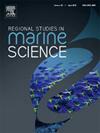纳米塑料和磷酸三(2-氯丙基)对滨海小球藻光合作用和抗氧化活性的联合影响
IF 2.1
4区 环境科学与生态学
Q3 ECOLOGY
引用次数: 0
摘要
纳米塑料(NPs)和三(2-氯丙基)磷酸(TCPP)等有机磷酯是全球关注的新兴海洋生态系统污染物。然而,它们对初级生产者的综合生态毒理学影响仍然知之甚少。我们研究了100 nm NPs(10 ³项·L⁻¹)和TCPP(0.5-50 μg·L⁻¹)在72小时内对海洋小球藻(小球藻marina)的影响。生理反应(如叶绿素a, Fv/Fm)和抗氧化活性(包括超氧化物歧化酶(SOD),过氧化氢酶(CAT),谷胱甘肽(GSH),丙二醛(MDA))被量化,并通过扫描电子显微镜(SEM)观察细胞相互作用。我们发现,与单一暴露相比,联合暴露显著降低了叶绿素a含量(降低38-52 %)和光合效率(Fv/Fm降低30-45 %)(p <; 0.01)。NPs吸附在藻表面,加剧了tcpp诱导的氧化应激:SOD和CAT活性增加2.3 - 3.5倍,而MDA水平上升60 - 80% %,表明严重的膜损伤。协同作用呈浓度依赖性,高剂量TCPP(50 μg·L⁻¹)+ NPs的抑制作用最为明显。NPs作为载体增强TCPP的毒性,破坏光合作用和抗氧化系统。这些发现强调了评估海洋环境中综合污染物风险的必要性,特别是在NPs和OPEs共同发生的城市化沿海地区。本文章由计算机程序翻译,如有差异,请以英文原文为准。
Combined effects of nanoplastics and tris (2-chloropropyl) phosphate on photosynthesis and antioxidant activity in Chlorella marina
Nanoplastics (NPs) and organophosphorus esters like tris (2-chloropropyl) phosphate (TCPP) are emerging pollutants of global concern in marine ecosystems. However, their combined ecotoxicological effects on primary producers remain poorly understood. We investigated the impacts of 100 nm NPs (10 ³ items·L⁻¹) and TCPP (0.5–50 μg·L⁻¹) on the marine microalga Chlorella (Chlorella marina) during 72-hour exposures. Physiological responses (e.g., chlorophyll a, Fv/Fm) and antioxidant activities (including superoxide dismutase (SOD), catalase (CAT), glutathione (GSH), malondialdehyde (MDA)) were quantified, complemented by scanning electron microscopy (SEM) to observe cellular interactions. We found the combined exposure significantly reduced chlorophyll a content (by 38–52 %) and photosynthetic efficiency (Fv/Fm by 30–45 %) compared to single exposures (p < 0.01). NPs adsorbed onto algal surfaces, exacerbating TCPP-induced oxidative stress: SOD and CAT activities increased 2.3–3.5-fold, while MDA levels rose by 60–80 %, indicating severe membrane damage. The synergistic effects were concentration-dependent, with high-dose TCPP (50 μg·L⁻¹) + NPs causing the most pronounced inhibition. NPs act as carriers to enhance TCPP toxicity in C. marina, disrupting photosynthesis and antioxidant systems. These findings highlight the need to evaluate combined pollutant risks in marine environments, particularly in urbanized coasts where NPs and OPEs co-occur.
求助全文
通过发布文献求助,成功后即可免费获取论文全文。
去求助
来源期刊

Regional Studies in Marine Science
Agricultural and Biological Sciences-Ecology, Evolution, Behavior and Systematics
CiteScore
3.90
自引率
4.80%
发文量
336
审稿时长
69 days
期刊介绍:
REGIONAL STUDIES IN MARINE SCIENCE will publish scientifically sound papers on regional aspects of maritime and marine resources in estuaries, coastal zones, continental shelf, the seas and oceans.
 求助内容:
求助内容: 应助结果提醒方式:
应助结果提醒方式:


